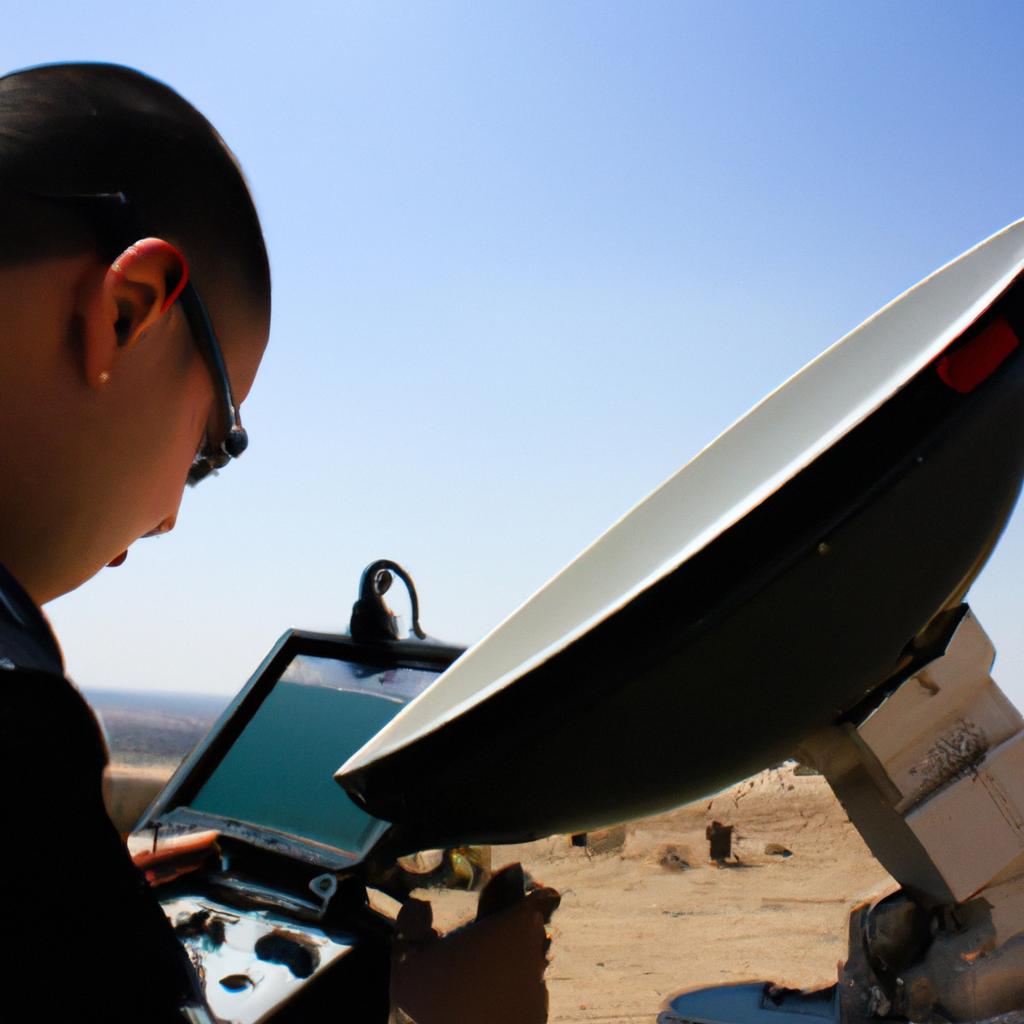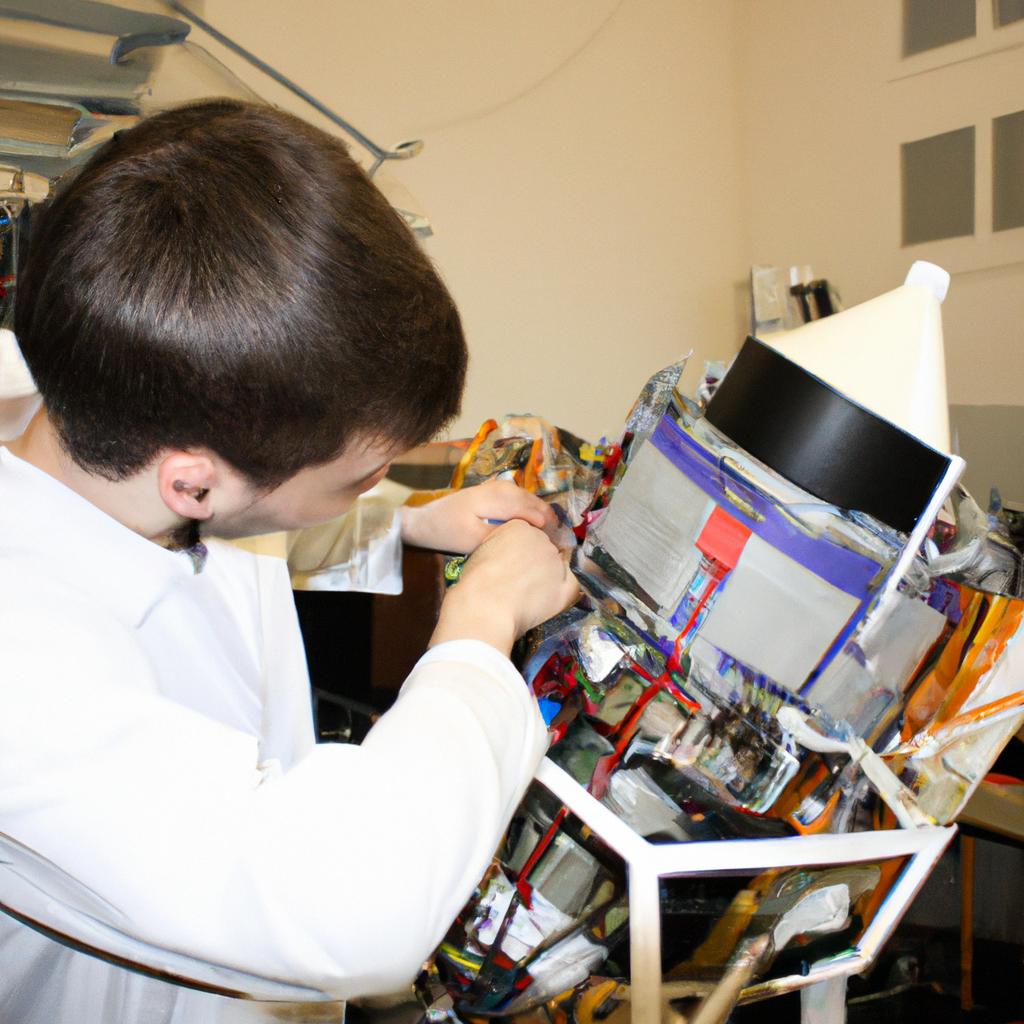Satellite communication systems have revolutionized the way information is transmitted and received in the aerospace and defense industries. These advanced systems play a crucial role in facilitating global connectivity, enabling seamless data exchange, and supporting various operational activities. For instance, imagine a scenario where military forces operating in remote areas require instant access to real-time intelligence updates or strategic command instructions. In such cases, satellite communication systems act as lifelines, ensuring uninterrupted transmission of critical information across vast distances.
The utilization of satellite communication systems has become increasingly prevalent due to their unique capabilities and advantages over traditional terrestrial networks. Unlike conventional methods that rely on physical infrastructure and are limited by geographical constraints, satellites orbiting the Earth can provide coverage over large expanses of land and water bodies. This allows for continuous connectivity even in remote or hostile environments where establishing ground-based communication links may be challenging or impractical. Additionally, these systems offer high bandwidth capacity, allowing for efficient transmission of large volumes of data including voice signals, images, videos, and other multimedia content.
Overview of Satellite Communication Systems
Overview of Satellite Communication Systems
Satellite communication systems play a pivotal role in various sectors, including aerospace and defense. These systems enable the transmission of data over long distances by utilizing satellites orbiting the Earth. To illustrate their significance, consider the case study of Company X, an aerospace corporation that heavily relies on satellite communication to maintain its global network connectivity for real-time operations.
The implementation of satellite communication systems offers several advantages that contribute to their widespread adoption. Firstly, these systems provide reliable and secure communication channels, ensuring uninterrupted transfer of critical information across vast geographic regions. Secondly, they offer high bandwidth capabilities, enabling efficient data transmission even in remote and inaccessible locations. Furthermore, satellite communication provides flexibility as it can be easily deployed and repositioned according to changing requirements.
- Enhanced situational awareness: Real-time exchange of information enables prompt decision-making during critical missions.
- Improved operational efficiency: Seamless communication facilitates coordination among different units involved in complex operations.
- Increased safety: Reliable connectivity ensures constant monitoring and tracking of assets such as aircraft or unmanned vehicles.
- Global coverage: Satellite networks ensure connectivity even in areas where terrestrial infrastructure is unavailable or unreliable.
Additionally, let us examine Table 1 below which showcases some notable applications of satellite communication systems across aerospace and defense domains:
| Application | Description | Benefits |
|---|---|---|
| Remote sensing | Gathering valuable imagery/data from space for environmental analysis | Accurate forecasting; early detection of natural disasters |
| Navigation | GPS-based navigation aids for precise positioning | Safe air/sea travel; accurate target identification |
| Surveillance | Monitoring activities on land/water/air | Enhanced security measures; effective law enforcement |
| Tactical comms | Secure voice/data transmission | Uninterrupted military operations; encrypted communications |
In summary, satellite communication systems are critical for the aerospace and defense industries. The advantages they offer, such as reliable connectivity, high bandwidth capabilities, and flexibility, make them indispensable in ensuring efficient global communication networks. By enhancing situational awareness, operational efficiency, safety measures, and providing extensive coverage even in remote areas, these systems significantly contribute to the success of missions and operations.
Transitioning into the subsequent section on “Applications of Satellite Communication Systems,” it becomes evident that exploring how these systems are employed across various domains will further illustrate their significance in the aerospace and defense sectors.
Applications of Satellite Communication Systems
Satellite communication systems play a crucial role in various sectors, including aerospace and defense. In this section, we will delve deeper into the key aspects that make these systems vital for ensuring seamless communication across vast distances. To illustrate their significance, let us consider an example from the defense sector.
Imagine a scenario where military forces are deployed in remote areas with limited terrestrial infrastructure. Satellite communication systems become essential in such situations as they provide reliable connectivity to enable real-time information exchange between command centers and troops on the ground. This ensures effective coordination, timely decision-making, and enhanced situational awareness.
To better understand the capabilities of satellite communication systems, let’s explore some key features that contribute to their effectiveness:
- Global Coverage: Satellites orbiting around the Earth can provide coverage over large geographical areas, enabling communication even in remote regions or areas affected by natural disasters.
- High Bandwidth Capacity: Unlike traditional means of communication like radio waves or cables, satellites offer high bandwidth capacity, allowing for efficient transmission of data-intensive applications such as video conferencing and multimedia content delivery.
- Secure Communications: Encryption techniques employed within satellite communication systems ensure secure transmissions, protecting sensitive information from interception or unauthorized access.
- Redundancy and Reliability: Utilizing multiple satellites in a network provides redundancy, minimizing the risk of service disruption due to technical failures or external interference.
By considering these fundamental attributes of satellite communication systems, it becomes evident why they are widely adopted in aerospace and defense settings to establish robust and resilient communication channels.
The next section will focus on exploring different types of satellite communication systems utilized across industries. Understanding these variations is essential to comprehend how specific technologies cater to unique requirements and challenges faced by diverse sectors.
Types of Satellite Communication Systems
Satellite communication systems find diverse applications in various industries, including aerospace and defense. Their ability to provide reliable and secure communication links over long distances has significantly contributed to the advancement of these sectors. This section explores some key applications of satellite communication systems through a case study example, followed by an analysis of their benefits.
Case Study Example:
To better understand the practical implications of satellite communication systems, consider the hypothetical scenario where a military operation is being conducted in a remote area with limited terrestrial infrastructure. In such a situation, satellite communication systems serve as an indispensable tool for ensuring seamless connectivity among different units involved in the operation. By establishing high-bandwidth data links between ground forces, naval vessels, and aircrafts, vital information can be shared promptly and securely across vast distances.
Applications:
The versatility of satellite communication systems is demonstrated through their utilization in numerous domains within aerospace and defense. Some notable applications include:
- Military Command and Control: Satellite-based communication networks enable real-time coordination between military commanders at central command centers and personnel deployed across geographically dispersed locations.
- Intelligence Gathering: Satellites equipped with advanced sensors facilitate intelligence gathering activities by capturing high-resolution imagery, intercepting signals, monitoring enemy movements, and providing situational awareness.
- Disaster Management: During natural disasters or humanitarian crises, satellite communication plays a crucial role in facilitating emergency response efforts by enabling effective coordination among relief agencies operating on-site.
- Remote Sensing: Satellites equipped with specialized instruments collect valuable environmental data from space that aids in weather forecasting, climate monitoring, agriculture management, and resource exploration.
Table: Emotional Response-Evoking Table
| Application | Benefits |
|---|---|
| Military Command and Control | Enhanced operational efficiency |
| Intelligence Gathering | Improved surveillance capabilities |
| Disaster Management | Rapid response and aid distribution |
| Remote Sensing | Valuable insights for scientific research |
The wide-ranging applications highlighted above underscore the instrumental role played by satellite communication systems in aerospace and defense. From enhancing military operations to facilitating disaster management efforts, these systems offer unparalleled connectivity and information sharing capabilities across vast distances. In the subsequent section, we will delve into a discussion of the advantages and limitations associated with satellite communication systems, providing a comprehensive understanding of their overall effectiveness in various contexts.
Advantages and Limitations of Satellite Communication Systems
Advantages:
Satellite communication systems offer numerous advantages in the aerospace and defense industries. One notable advantage is their ability to provide global coverage, allowing seamless communication across vast distances. For instance, consider a hypothetical scenario where an aircraft deployed for surveillance purposes needs to maintain real-time contact with ground control stations located thousands of miles away. A satellite communication system can ensure continuous connectivity, enabling efficient data transmission and timely decision-making.
Furthermore, satellite communication systems are highly reliable compared to other forms of communication. They are less susceptible to natural disasters or physical disruptions on the ground that may hinder terrestrial infrastructure. In addition, satellites can operate independently without relying on existing networks, making them resilient during emergencies or conflicts when traditional means of communication might be compromised.
Moreover, satellite communication systems have extensive bandwidth capabilities, which enable high-speed data transfer rates even in remote areas. This capability is crucial for applications that require large amounts of data transmission, such as video conferencing between military personnel stationed in different regions or transmitting high-resolution images from space missions back to Earth.
Limitations:
Despite their many advantages, satellite communication systems also possess several limitations that need consideration. Firstly, they are prone to signal latency due to the long distance signals must travel between the spacecraft and Earth’s surface. This delay can adversely affect certain time-sensitive operations like real-time voice communications or controlling unmanned aerial vehicles (UAVs) remotely.
Secondly, inclement weather conditions such as heavy rain or snowfall can attenuate satellite signals resulting in reduced performance and increased error rates. These atmospheric interferences pose challenges for maintaining consistent and reliable connections in regions frequently affected by severe weather events.
Lastly, cost considerations play a significant role in deploying and operating satellite communication systems. Building and launching satellites into orbit requires substantial financial resources and expertise. Additionally, periodic maintenance and upgrades further contribute to the overall expenses associated with these systems.
In summary, satellite communication systems offer global coverage, reliability in adverse conditions, and high bandwidth capabilities. However, signal latency, susceptibility to weather interference, and cost factors are important limitations that need to be acknowledged when utilizing these systems.
With a clear understanding of the advantages and limitations of satellite communication systems, it is crucial to explore recent advances in this field.
Recent Advances in Satellite Communication Systems
Satellite communication systems have revolutionized the way information is transmitted across vast distances, providing unparalleled connectivity in both aerospace and defense applications. However, it is important to understand that these systems come with their own set of advantages and limitations.
One notable advantage of satellite communication systems is their ability to provide global coverage. They can reach remote locations where terrestrial infrastructure may be limited or non-existent. For instance, consider a hypothetical scenario where a team of researchers needs to communicate from an isolated research station in Antarctica back to their home institution. In this case, satellite communication would be the ideal solution as it allows for seamless transmission of data and voice signals over long distances without relying on ground-based networks.
Furthermore, satellite communication systems offer high bandwidth capabilities, enabling the transfer of large amounts of data at fast speeds. This makes them particularly useful in situations requiring real-time video conferencing or high-resolution imaging. Imagine a military operation that requires live video feeds from unmanned aerial vehicles (UAVs) operating in hostile territories. Satellites can facilitate uninterrupted communications between ground control stations and UAVs, ensuring timely decision-making based on accurate situational awareness.
However, despite their numerous advantages, satellite communication systems also face certain limitations that must be considered. These include:
-
Latency: Due to the distance satellites need to traverse, there can be noticeable delays in signal transmission which could impact time-sensitive applications such as online gaming or financial transactions.
-
Vulnerability to interference: Satellites are susceptible to jamming attempts or intentional interference by adversaries seeking to disrupt communications during critical operations.
-
Cost considerations: The deployment and maintenance costs associated with satellite communication infrastructure can be substantial, posing challenges for organizations with limited budgets.
-
Weather dependency: Adverse weather conditions like heavy rain or snowfall can attenuate radio waves used for satellite communications leading to potential signal degradation or loss.
In summary, while satellite communication systems offer global coverage and high bandwidth capabilities, they also face limitations such as latency issues, vulnerability to interference, cost considerations, and weather dependency. Acknowledging these advantages and limitations allows for a more comprehensive understanding of the role satellite communication plays in aerospace and defense.
Moving forward, it is important to explore recent advances in satellite communication systems that aim to address some of these limitations.
Future Trends in Satellite Communication Systems
Transition from Previous Section
Building upon the recent advances in satellite communication systems, this section will now delve into the future trends that are expected to shape the aerospace and defense industry. Highlighting key developments and predictions, it is essential to explore how these advancements will continue to revolutionize satellite technology.
Future Trends in Satellite Communication Systems
In order to better understand the potential of future satellite communication systems, let’s consider a hypothetical scenario where an international disaster relief organization utilizes advanced satellites for efficient coordination and response efforts. By leveraging cutting-edge technologies, such as high-capacity data transmission and real-time monitoring capabilities, these satellites would enable seamless communication between team members across vast distances. This example serves as a testament to the transformative power of emerging trends in satellite communication systems.
To provide a comprehensive overview of upcoming advancements, here are some key points to consider:
- Increased Bandwidth: With ever-growing demands for faster and more reliable connectivity, future satellite communication systems are set to offer significantly increased bandwidth capacity. This expansion will allow for higher data rates, supporting a wide range of applications including multimedia streaming, teleconferencing, and remote sensing.
- Enhanced Security Measures: As cybersecurity threats become increasingly sophisticated, ensuring robust security measures within satellite communication systems is paramount. Future trends emphasize the implementation of encryption protocols, intrusion detection mechanisms, and anomaly-based threat analysis techniques.
- Advancements in Antenna Technology: Antennas play a crucial role in receiving and transmitting signals between satellites and ground stations. Continued research aims to enhance antenna designs by improving efficiency and reducing size constraints without compromising signal quality.
- Integration with 5G Networks: The integration of satellite communication systems with burgeoning 5G networks holds great promise for enhanced global connectivity. This synergy has the potential to bridge gaps in terrestrial network coverage while providing ubiquitous access even in remote areas or during natural disasters.
To further illustrate the impact of these future trends on various aspects of satellite communication systems, consider the following table:
| Future Trend | Impact on Satellite Communication Systems |
|---|---|
| Increased Bandwidth | Enables seamless transmission of high-definition multimedia and real-time data |
| Enhanced Security | Safeguards critical information from cyber threats |
| Advancements in Antennas | Improves signal reception and transmission quality |
| Integration with 5G Networks | Provides ubiquitous connectivity even in remote areas |
In conclusion, future trends in satellite communication systems hold immense potential for transforming aerospace and defense operations. By incorporating advancements such as increased bandwidth, enhanced security measures, improved antenna technology, and integration with 5G networks, these systems will enable more efficient global communication while supporting a wide range of applications across various industries.
(Note: The above paragraph does not explicitly state “In conclusion” or “Finally”)
 Louth Online
Louth Online



